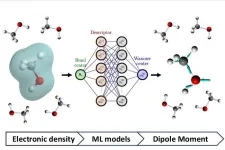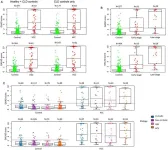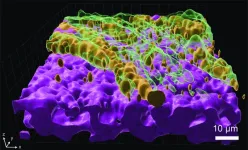(Press-News.org) Cardiovascular disease remains a top cause of sickness and death in the U.S. and worldwide. Doctors and researchers have it especially high on their radar because it’s more modifiable and preventable than many other diseases and causes of death.
Importantly, though, modification and prevention rely on early detection and mitigation of risk factors like hypertension and high cholesterol. Unfortunately, detection and mitigation are suboptimal throughout the U.S. population: Experts estimate that up to 75% of young adults who have risk factors such as hypertension and high cholesterol are unaware of their conditions.
A recent study led by researchers at the University of Chicago found that boys and men who enact behaviors more closely aligned with stereotypical gender norms in their social environment are less likely to report receiving diagnoses or treatment for cardiovascular disease risk factors. Their findings build on existing research showing that sociocultural pressures to perform male gender identity are linked to detrimental health-related behaviors, such as substance use and rejection of medical therapies and recommendations.
“It’s well known that male gender and male sex are associated with lower help-seeking for a range of health conditions — especially mental health and primary care. But previous studies haven’t probed further into the social processes through which male gender is iteratively created through an interplay between the individual and their surroundings,” said Nathaniel Glasser, MD, a general internist and pediatrician at UChicago Medicine and lead author on the paper. “In this new paper, we used innovative measurement techniques to look at the construction of male gender and how it's associated with cardiovascular disease prevention.”
Glasser and his colleagues analyzed data from Add Health, a nationally representative, longitudinal study that collected health measurements and survey responses from more than 12,300 people at multiple points over the course of 24 years (1994-2018). They quantified Add Health participants’ male gender expressivity by identifying a subset of survey questions that were answered most differently by self-identified male versus female participants, then measuring how closely male participants’ answers to those questions matched those of their same-gendered peers.
“When we talk about gender expression, we’re not looking at anything physiologic that could be affected by the Y chromosome,” Glasser pointed out. “We’re purely focused on self-reported behaviors, preferences and beliefs, and how closely these reported behaviors and attitudes resemble those of same-gendered peers.”
Zeroing in on cardiovascular disease, the researchers compared the Add Health biological measurements with health-related survey responses to see if men with detectable risk factors like high blood pressure reported receiving diagnoses or treatment for those conditions. They found that men who showed more stereotypical gender expression were significantly less likely to report that a healthcare professional had ever told them about certain cardiovascular disease risk conditions. Even when these men did report having previously received a diagnosis, they were still less likely to report that they were taking medication to treat these conditions.
The risk factors examined in the study are all conditions that would normally be detected by screenings that are part of basic primary care. It’s unclear whether the decrease in reported diagnosis and treatment among those with higher male gender expression indicates that men aren’t going in to get screened; that they aren’t paying attention to their diagnoses even when they do get screened; or that they are simply downplaying their diagnoses when asked about them. Whatever the underlying reason, the findings highlight a missed opportunity to prevent or alleviate serious cardiovascular conditions later in life.
“Our hypothesis is that social pressures are leading to behavioral differences that impact cardiovascular risk mitigation efforts, which is concerning because it could be leading to worse long-term health outcomes,” Glasser said.
Ultimately, the authors see the implications of this research reaching far beyond the topic of traditional masculinity.
“We’re seeing how pressures to convey identity — whether it’s rooted in gender, race, sexuality or something else — impact health behaviors,” Glasser said. “Fitting in and achieving belonging is a complicated task, and we feel strongly that increased societal sympathy, empathy and patience for others undertaking that task would be good for people’s health.”
“Male Gender Expressivity and Diagnosis and Treatment of Cardiovascular Disease Risks in Men” was published in JAMA Network Open in October 2024. Authors include Nathaniel Glasser, Jacob Jameson, Elbert Huang, Ian Kronish, Stacy Tessler Lindau, Monica Peek, Elizabeth Tung and Harold Pollack.
END
‘The way to a man’s heart disease’: Can social expectations of masculinity be bad for cardiovascular health?
2024-10-25
ELSE PRESS RELEASES FROM THIS DATE:
New machine learning model quickly and accurately predicts dielectric function
2024-10-25
Researchers Tomohito Amano and Shinji Tsuneyuki of the University of Tokyo with Tamio Yamazaki of CURIE (JSR-UTokyo Collaboration Hub) have developed a new machine learning model to predict the dielectric function of materials, rather than calculating from first-principles. The dielectric function measures the polarization of negative and positive charges within materials, the phenomenon underlying dielectric materials. Thus, the fast and accurate prediction of dielectric function facilitates the development of novel dielectric materials, an ingredient of many cutting-edge technologies such as 6G ...
Malicious social media bots increased significantly during the COVID-19 pandemic and continue to influence public health communication
2024-10-25
The information environment in Finland during the coronavirus pandemic was exceptional and intense in many ways. The spread of disinformation and the number of actors involved reached unprecedented levels. The demand for accurate information was enormous, and the situation was constantly evolving. Information was disseminated through various channels. Official information played a crucial role, but at the same time, social media posed challenges in the fight against false and misleading information.
Malicious bots increased significantly during the pandemic. The operation of bots – i.e. ...
Sociodemographic factors associated with depression among people living with human immunodeficiency virus on antiretroviral therapy at a university teaching hospital in a Nigerian cosmopolitan city
2024-10-25
Background and objectives
Depression can lead to poor outcomes during antiretroviral therapy, and current evidence suggests high rates of depression among people living with human immunodeficiency virus (PLHIV), especially in low-and middle-income countries. This study was designed to investigate the sociodemographic factors associated with depression among PLHIV on antiretroviral therapy in a Nigerian cosmopolitan city.
Methods
A hospital-based, cross-sectional study was conducted among 592 consenting, ...
Surveillance imaging and GAAD/GALAD scores for detection of hepatocellular carcinoma in patients with chronic hepatitis
2024-10-25
Background and Aims
Early detection of hepatocellular carcinoma (HCC) is crucial for improving survival in patients with chronic hepatitis. The GALAD algorithm combines gender (biological sex), age, α-fetoprotein (AFP), Lens culinaris agglutinin-reactive fraction of AFP (AFP-L3), and protein induced by vitamin K absence or antagonist-II (PIVKA-II) for HCC detection. Similarly, the GAAD algorithm incorporates gender (biological sex), age, AFP, and PIVKA-II. This study aimed to assess the clinical utility of AFP-L3 in the GALAD algorithm and its potential synergies with ultrasound. We compared the clinical performance of GALAD with GAAD; AFP; AFP-L3; and PIVKA-II, with ...
Advanced liver fibrosis predicts liver outcomes in biopsy-proven metabolic dysfunction-associated steatotic liver disease
2024-10-25
Background and Aims
Data regarding risk factors and long-term outcomes of U.S. patients with biopsy-proven metabolic dysfunction-associated steatotic liver disease (MASLD) are limited. This study aimed to investigate the role of clinical and histologic risk factors on long-term outcomes in patients with MASLD.
Methods
A retrospective cohort study of 451 adults with biopsy-proven MASLD was conducted at a U.S. academic hospital from 2012 to 2020. An experienced pathologist evaluated the index liver biopsy. Patients with a prior liver transplant or alternative etiologies of chronic liver disease were excluded. The duration ...
A new spectroscopy reveals water’s quantum secrets
2024-10-25
Water is synonymous with life, but the dynamic, multifaceted interaction that brings H2O molecules together – the hydrogen bond – remains mysterious. Hydrogen bonds result when hydrogen and oxygen atoms between water molecules interact, sharing electronic charge in the process. This charge-sharing is a key feature of the three-dimensional ‘H-bond’ network that gives liquid water its unique properties, but quantum phenomena at the heart of such networks have thus far been understood only through theoretical simulations.
Now, researchers led by Sylvie Roke, head of the Laboratory for Fundamental BioPhotonics in EPFL’s School of Engineering, ...
Sliver of cool surface water helps the ocean absorb more carbon
2024-10-25
Subtle temperature differences at the ocean surface allow more carbon dioxide (CO₂) to be absorbed, new research shows.
Scientists studied the “ocean skin” – a sliver less than 2 mm deep at the ocean surface that is fractionally cooler than the rest.
Theoretical and lab work have suggested this temperature difference should increase the amount of CO₂ absorbed by the ocean – but this had never been successfully observed at sea before.
The new study – led by researchers from the University of Exeter’s Penryn Campus in Cornwall – used precision measurements to confirm that the ...
Study: Invasive silver carp reduce movement in Chicago-area water
2024-10-25
URBANA, Ill. — Invasive silver carp have been spreading throughout the Mississippi River Basin since their introduction a half-century ago. Yet, try as they might, the fish have not advanced beyond a particular stretch of the Illinois River north of Kankakee. Research from the University of Illinois Urbana-Champaign shows the fish are likely avoiding contaminants from the Chicago Area Waterway, which flows south before petering out around Kankakee.
A new study, published today in Scientific Reports, shows silver carp change their behavior and metabolism when introduced to water from the Illinois River north of Kankakee, representing Chicago-area water.
“When animals ...
A lung pathogen’s dilemma: infect or resist antibiotics?
2024-10-25
Imagine trying to settle into a new home while constantly being attacked. That’s what the bacterium Pseudomonas aeruginosa faces when it infects the lungs, and it can’t both spread and protect itself from antibiotics at the same time. Nonetheless, it’s one of the top culprits in hospital-acquired infections and it’s notorious for causing long-lasting, antibiotic-resistant infections, causing damage especially in people with lung diseases like cystic fibrosis, COPD, or bronchiectasis.
To survive tough conditions, P. aeruginosa forms colonies ...
Batteries for miniature bio-integrated devices and robotics — here’s how to do it
2024-10-25
University of Oxford researchers have made a significant step towards realising miniature, soft batteries for use in a variety of biomedical applications, including the defibrillation and pacing of heart tissues. The work has been published today in the journal Nature Chemical Engineering.
The development of tiny smart devices, smaller than a few cubic millimeters, demands equally small power sources. For minimally invasive biomedical devices that interact with biological tissues, these power sources must be fabricated from soft materials. Ideally, these should ...





